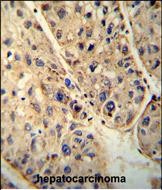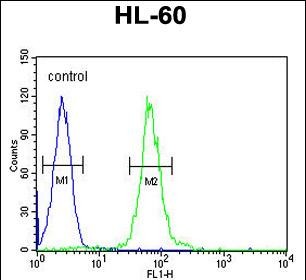ABCD1 Antibody (Center)
Affinity Purified Rabbit Polyclonal Antibody (Pab)
- 产品详情
- 实验流程
- 背景知识
Application
| WB, IHC-P, FC, E |
|---|---|
| Primary Accession | P33897 |
| Other Accession | P48410, NP_000024.2 |
| Reactivity | Human, Mouse |
| Predicted | Mouse |
| Host | Rabbit |
| Clonality | Polyclonal |
| Isotype | Rabbit IgG |
| Calculated MW | 82937 Da |
| Antigen Region | 257-285 aa |
| Gene ID | 215 |
|---|---|
| Other Names | ATP-binding cassette sub-family D member 1, Adrenoleukodystrophy protein, ALDP, ABCD1, ALD |
| Target/Specificity | This ABCD1 antibody is generated from rabbits immunized with a KLH conjugated synthetic peptide between 257-285 amino acids from the Central region of human ABCD1. |
| Dilution | WB~~1:2000 IHC-P~~1:100~500 FC~~1:10~50 E~~Use at an assay dependent concentration. |
| Format | Purified polyclonal antibody supplied in PBS with 0.09% (W/V) sodium azide. This antibody is purified through a protein A column, followed by peptide affinity purification. |
| Storage | Maintain refrigerated at 2-8°C for up to 2 weeks. For long term storage store at -20°C in small aliquots to prevent freeze-thaw cycles. |
| Precautions | ABCD1 Antibody (Center) is for research use only and not for use in diagnostic or therapeutic procedures. |
| Name | ABCD1 (HGNC:61) |
|---|---|
| Synonyms | ALD |
| Function | ATP-dependent transporter of the ATP-binding cassette (ABC) family involved in the transport of very long chain fatty acid (VLCFA)- CoA from the cytosol to the peroxisome lumen (PubMed:11248239, PubMed:15682271, PubMed:16946495, PubMed:18757502, PubMed:21145416, PubMed:23671276, PubMed:29397936, PubMed:33500543). Coupled to the ATP- dependent transporter activity also has a fatty acyl-CoA thioesterase activity (ACOT) and hydrolyzes VLCFA-CoA into VLCFA prior their ATP- dependent transport into peroxisomes, the ACOT activity is essential during this transport process (PubMed:29397936, PubMed:33500543). Thus, plays a role in regulation of VLCFAs and energy metabolism namely, in the degradation and biosynthesis of fatty acids by beta-oxidation, mitochondrial function and microsomal fatty acid elongation (PubMed:21145416, PubMed:23671276). Involved in several processes; namely, controls the active myelination phase by negatively regulating the microsomal fatty acid elongation activity and may also play a role in axon and myelin maintenance. Also controls the cellular response to oxidative stress by regulating mitochondrial functions such as mitochondrial oxidative phosphorylation and depolarization. And finally controls the inflammatory response by positively regulating peroxisomal beta-oxidation of VLCFAs (By similarity). |
| Cellular Location | Peroxisome membrane; Multi-pass membrane protein. Mitochondrion membrane; Multi-pass membrane protein. Lysosome membrane; Multi-pass membrane protein Endoplasmic reticulum membrane; Multi- pass membrane protein |
For Research Use Only. Not For Use In Diagnostic Procedures.
Provided below are standard protocols that you may find useful for product applications.
BACKGROUND
ABCD1 is a member of the superfamily of ATP-binding cassette (ABC) transporters. ABC proteins transport various molecules across extra- and intra-cellular membranes. ABC genes are divided into seven distinct subfamilies (ABC1, MDR/TAP, MRP, ALD, OABP, GCN20, White). This protein is a member of the ALD subfamily, which is involved in peroxisomal import of fatty acids and/or fatty acyl-CoAs in the organelle. All known peroxisomal ABC transporters are half transporters which require a partner half transporter molecule to form a functional homodimeric or heterodimeric transporter. This peroxisomal membrane protein is likely involved in the peroxisomal transport or catabolism of very long chain fatty acids. Defects in this gene have been identified as the underlying cause of adrenoleukodystrophy, an X-chromosome recessively inherited demyelinating disorder of the nervous system.
REFERENCES
Matsukawa, T., et al. Neurogenetics (2010) In press :
Xie, H.H., et al. Zhonghua Yi Xue Yi Chuan Xue Za Zhi 27(2):144-148(2010)
Li, J.Y., et al. J. Neurol. Sci. 290 (1-2), 163-165 (2010) :
Hour, T.C., et al. Int. J. Biol. Markers 24(3):171-178(2009)
Shukla, P., et al. J. Child Neurol. 24(7):857-860(2009)
终于等到您。ABCEPTA(百远生物)抗体产品。
点击下方“我要评价 ”按钮提交您的反馈信息,您的反馈和评价是我们最宝贵的财富之一,
我们将在1-3个工作日内处理您的反馈信息。
如有疑问,联系:0512-88856768 tech-china@abcepta.com.























 癌症的基本特征包括细胞增殖、血管生成、迁移、凋亡逃避机制和细胞永生等。找到癌症发生过程中这些通路的关键标记物和对应的抗体用于检测至关重要。
癌症的基本特征包括细胞增殖、血管生成、迁移、凋亡逃避机制和细胞永生等。找到癌症发生过程中这些通路的关键标记物和对应的抗体用于检测至关重要。 为您推荐一个泛素化位点预测神器——泛素化分析工具,可以为您的蛋白的泛素化位点作出预测和评分。
为您推荐一个泛素化位点预测神器——泛素化分析工具,可以为您的蛋白的泛素化位点作出预测和评分。 细胞自噬受体图形绘图工具为你的蛋白的细胞受体结合位点作出预测和评分,识别结合到自噬通路中的蛋白是非常重要的,便于让我们理解自噬在正常生理、病理过程中的作用,如发育、细胞分化、神经退化性疾病、压力条件下、感染和癌症。
细胞自噬受体图形绘图工具为你的蛋白的细胞受体结合位点作出预测和评分,识别结合到自噬通路中的蛋白是非常重要的,便于让我们理解自噬在正常生理、病理过程中的作用,如发育、细胞分化、神经退化性疾病、压力条件下、感染和癌症。








